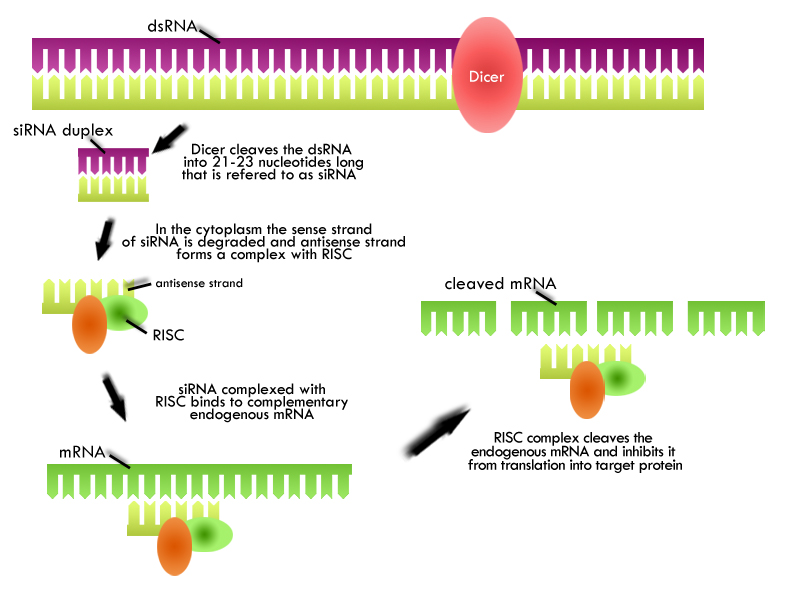Diagram: Basic overview of RNAi mechanism: Double stranded RNA is introduced into a cell and gets chopped up by the enzyme dicer to form siRNA then binds to the RNA-induced silencing complex (RISC) and is unwound. The antisense RNA complexed with RISC binds to its corresponding mRNA which is then cleaved by the enzyme slicer and makes it inactive.
RNA interference may offer a cure
Through years, better understanding of the pathway to the progression of HD has allowed for development of different therapeutic approaches. Although, all of which have only been able to either slow the progression of the disease or repair caused damage. None of them in particular introduced a cure for HD. However, more recently, new technique done on animals called RNA interference (RNAi) based approach has shown encouraging results, which gives hope (14).
RNAi has been discovered as a system within organisms, which helps control specific gene activation and the level to which they are activated (14). The recognized advantage of this technique is its ability to suppress Htt gene (15). RNAi bring about gene silencing by using homologous double stranded RNA (16). dsRNA is introduced to a cell and once it is in the cytoplasm it gets processed by the enzyme dicer, which recognizes and cleaves the dsRNA into small pieces of 21-23 nucleotides long (14). These small-cleaved nucleotides are referred to as small interfering RNA (siRNA). The two strands of siRNA are referred to as sense and antisense with respect to the target mRNA (16). The antisense acts as the template for the sequence-specific gene silencing. And the sense strand is called the passenger strand, which is degraded (14).
Accordingly, in the cytoplasm, the sense strand of the siRNA is degraded and the antisense strand associates with RNA-induced silencing complex (RISC) to form an RNA- protein complex (14). The anti-sense of the protein complex further binds to the endogenous mRNA and silences the gene expression by cleaving the mRNA (this mechanism is illustrated in Figure 1) (17).
In an experiment done on a HD mouse model (R6/2), siRNAs were directed against HD gene to inhibit mutant Htt gene expression (18). Subsequently, the result of this particular experiment showed that injection of siRNA at an early postnatal period does indeed inhibit huntingtin expression in brain neurons (18). However, the limitation to this method lies on the ability to introduce sufficient amount of siRNA into the target cells or tissues (16).
On a side note, it is also important to mention that there are other strategies out there such as post-translational modification (19). But none of them have shown similar promising results as RNAi approach. And in the case of post-translational modification they yet need to discover its biological function and underlying mechanism (19).
As a result, the purpose of this research is to develop techniques to further eliminate the limitation to RNAi base approach and introduce a technique to use this method in humans. Overcoming this issue will allow for direct targeting of the origin of HD and at last would give us a cure and an effective treatment.

